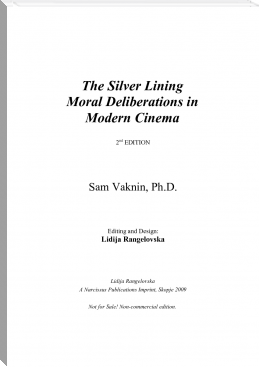Notes Of A Dead Man Sequel (Notes - #3) - Clive Cooper (e book reader android TXT) 📗

- Author: Clive Cooper
Book online «Notes Of A Dead Man Sequel (Notes - #3) - Clive Cooper (e book reader android TXT) 📗». Author Clive Cooper
“This has worked extremely well in 95 percent of the cases, but it has led to apparently irreconcilable differences in the remaining 5 percent.”
First to diverge
For the current study, published in Nature Ecology & Evolution, researchers decided to focus on 18 of these controversial relationships (seven from animals, five from plants, and six from fungi) in an attempt to figure out why studies have produced such strongly contradictory results. To do so, they got down into the weeds, genetically speaking, and began comparing individual genes of the leading contenders in each relationship.
“In these analyses, we only use genes that are shared across all organisms,” Rokas says. “The trick is to examine the gene sequences from different organisms to figure out who they identify as their closest relatives. When you look at a particular gene in an organism—let’s call it A—we ask if it is most closely related to its counterpart in organism B? Or to its counterpart in organism C? And by how much?”
These analyses typically involve hundreds to thousands of genes. The researchers determined how much support each gene provides to one hypothesis (comb jellies first) over another (sponges first). They labeled the resulting difference a “phylogenetic signal.” The correct hypothesis is the one that the phylogenetic signals from the most genes consistently favor.
In this fashion they determined that comb jellies have considerably more genes which support their “first to diverge” status in the animal lineage than do sponges.
Crocodile cousins
Another contentious relationship the researchers addressed was whether crocodiles are more closely related to birds or turtles. They found that 74 percent of the shared genes favor the hypothesis that crocodiles and birds are sister lineages while turtles are close cousins.
Ancient skull links turtles to birds
In the course of their study, they also discovered that in a number of contentious cases, one or two “strongly opinionated genes” among all the genes being analyzed appear to be causing the problem because the statistical methods that evolutionary biologists have been using are highly susceptible to their influence.
In some cases, such as controversies regarding the origins of flowering plants and modern birds, they determined that the removal of even a single opinionated gene can flip the results of an analysis from one candidate to another. In cases like this, the researchers were forced to conclude that the available data is either inadequate to support a definitive conclusion or it indicates that the diversification occurred too rapidly to resolve.
“We believe that our approach can help resolve many of these long-standing controversies and raise the game of phylogenetic reconstruction to a new level,” Rokas says.
The National Science Foundation, the Department of Energy Office of Science, the USDA National Institute of Food and Agriculture, and the National Institutes of Health funded the work.
Source: Vanderbilt University
Closer look casts doubt on big serotonin studyby Jim Dryden-WUSTL
Note: The truth is that not too much knowledge this time in this journey has come on the way... but still piece by piece... something are going to create.
P.S. - He has became a monster that's the truth!
New research shows that an influential 2003 study about the interaction of genes, environment, and depression may have missed the mark.
The 2003 study indicated that people with a particular variant of the serotonin transporter gene were not as well-equipped to deal with stressful life events and, when encountering significant stress, were more likely to develop depression.
Since its publication in Science, researchers have cited that original paper more than 4,000 times, and some 100 other studies have been published about links among a serotonin-related gene, stressful life events, and depression risk.
Hear more about the new study:Audio Player00:4703:00Use Up/Down Arrow keys to increase or decrease volume.
Such conclusions were widely accepted, mainly because antidepressant drugs called selective serotonin reuptake inhibitors (SSRIs) help relieve depression for a significant percentage of clinically depressed individuals, so many researchers thought it logical that differences in a gene affecting serotonin might be linked to depression risk.
But in this new study, researchers from Washington University School of Medicine in St. Louis looked again at data from the many studies that delved into the issue since the original publication in 2003, analyzing information from more than 40,000 people, and found that the previously reported connection among the serotonin gene, depression, and stress wasn’t evident. The new results appear in the journal Molecular Psychiatry.
“Our goal was to get everyone who had gathered data about this relationship to come together and take another look, with each research team using the same tools to analyze data the same way,” says first author Robert C. Culverhouse, an assistant professor of medicine and of biostatistics. “We all ran exactly the same statistical analyses, and after combining all the results, we found no evidence that this gene alters the impact stress has on depression.”
Brain scan may predict best depression treatment
Over the years, dozens of research groups had studied DNA and life experiences involving stress and depression in the more than 40,000 people revisited in this study. Some previous research indicated that those with the gene variant were more likely to develop depression when stressed, while others didn’t see a connection.
For almost two decades, scientists have debated the issue, and thousands of hours of research have been conducted. By getting all these groups to work together to reanalyze the data, this study should put the questions to rest, according to the researchers.
“…ultimately the question has to be not what the experts think but what the evidence tells us.”
“The idea that differences in the serotonin gene could make people more prone to depression when stressed was a very reasonable hypothesis,” says senior investigator Laura Jean Bierut, a professor of psychiatry. “But when all of the groups came together and looked at the data the same way, we came to a consensus. We still know that stress is related to depression, and we know that genetics is related to depression, but we now know that this particular gene is not.”
Newborn brain may hold predictors of anxiety, depression
Culverhouse notes that finally, when it comes to this gene and its connection to stress and depression, the scientific method has done its job.
“Experts have been arguing about this for years,” he says. “But ultimately the question has to be not what the experts think but what the evidence tells us. We’re convinced the evidence finally has given us an answer: This serotonin gene does not have a substantial impact on depression, either directly or by modifying the relationship between stress and depression.”
With this serotonin gene variant removed from the field of potential risk factors for depression, Culverhouse and Bierut say researchers now can focus on other gene-environment interactions that could influence the onset of depression.
Support for this work came from the National Institute on Drug Abuse and the National Institute of Mental Health of the National Institutes of Health, as well as the Wellcome Trust and other funding agencies from countries around the world. For a complete list of funding agencies and grants, please refer to the paper. Potential conflicts of interest involving researchers who are authors of the study also appear at the end of the paper.
Source: Washington University in St. Louis
Scientists can’t defeat water-repellent coating- Doubt is something normal!
....
- Science was changed once and again.
by Gabe Cherry-Michigan
A self-healing, water-repellent, spray-on coating is hundreds of times more durable than its counterparts.
The coating could waterproof vehicles, clothing, rooftops, and countless other surfaces for which current waterproofing treatments are too fragile. It could also lower the resistance of ship hulls, a step that would reduce the fuel consumption of the massive vessels that transport 90 percent of the world’s cargo.
Scientists say the new concoction is a breakthrough in a field where decades of research have failed to produce a durable coating. While water-repellent finishes are available at present, they’re typically not strong enough for applications like clothing or ship hulls. This discovery changes that.
“Thousands of super-hydrophobic surfaces have been looked at over the past 20 or 30 years, but nobody has been able to figure out how to systematically design one that’s durable,” says Anish Tuteja, associate professor of materials science and engineering at the University of Michigan.
“I think that’s what we’ve really accomplished here, and it’s going to open the door for other researchers to create cheaper, perhaps even better super-hydrophobic coatings.”
Thickness of new coating changes its color
The coating is made of a mix of a material called “fluorinated polyurethane elastomer” and a specialized water-repellent molecule known as “F-POSS.” It can be easily sprayed onto virtually any surface and has a slightly rubbery texture that makes it more resilient than its predecessors.
If it is damaged, the coating can heal itself hundreds of times. It can bounce back “even after being abraded, scratched, burned, plasma-cleaned, flattened, sonicated, and chemically attacked,” the researchers write in a paper published in ACS Applied Materials & Interfaces.
It can bounce back “even after being abraded, scratched, burned, plasma-cleaned, flattened, sonicated, and chemically attacked.”
In addition to recovering physically, the coating can heal itself chemically. If water-repellent F-POSS molecules are scraped from the surface, new molecules will naturally migrate there to replace them. That’s how the coating can renew itself hundreds of times. Its healing ability is limited only by its thickness.
Beyond the coatings detailed in the paper, the project produced what amounts to a recipe that researchers can use to optimize future coatings to a specific application’s requirements for cost, durability and other factors.
The team used a process that was radically different from previous research in the field, says doctoral student Kevin Golovin, the study’s lead author.
“Most materials science researchers have focused on identifying one specific chemical system that’s as durable and water-repellent as possible. We approached the problem differently, by measuring and mapping out the basic chemical properties that make a water-repellent coating durable. And some of the results surprised us.”
This crystal heals itself after cracking in two
For example, most hydrophobic coatings are made of two main ingredients: an active molecule that provides the water-repellency and a binder. Generally, researchers have assumed that using more durable ingredients would make a more durable coating. But Tuteja’s team found that that’s not necessarily the case.
Even more important than durability, they found, is a property called





Comments (0)